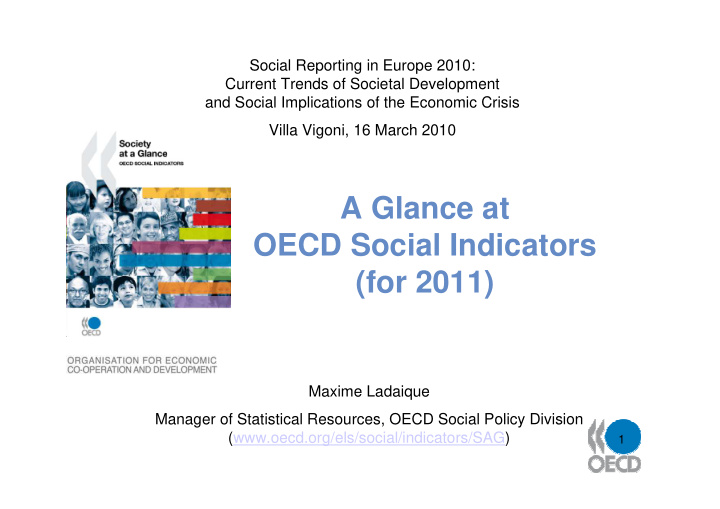



Social Reporting in Europe 2010: Current Trends of Societal Development and Social Implications of the Economic Crisis Villa Vigoni, 16 March 2010 A Glance at OECD Social Indicators (for 2011) Maxime Ladaique Manager of Statistical Resources, OECD Social Policy Division (www.oecd.org/els/social/indicators/SAG) 1
Outline What is OECD-SAG? 1. a. Background b. Goals c. Framework + the “special focus” chapter d. The OECD ”at a Glance” philosophy + example e. The on-line version of SAG What will be new in SAG2011? 2. a. Increase in country coverage b. Influence of the Stiglitz commission c. Examples (4) of 2011 social indicators To remember… 2
Part 1. What is OECD Society at a Glance ? 3
Background ● 1960s/70s -- calls for ‘ social accounting ’ – Key indicators to monitor general social trends ● OECD project begun in mid 1970s, with a first list of OECD indicators published in 1982, but no follow-up, till … ● … Early 2000s: the new OECD project SAG 2001 2003 2005 2006 2009(+SAG Asia) … 2011 4
The goals of OECD social indicators To give insights relevant to answering two questions: – What progress have OECD countries achieved in terms of their social development? – How effective have been the actions of society in furthering social development? Social indicators help in answering these two questions. Using national / international administrative and survey data, we compare social outcomes across OECD countries (and other countries) … using the following bi-dimensional framework… 5
Framework of OECD social indicators Area (4) 6
+ the special focus chapter ● SAG 2006: Measuring Well-Being – the Role of Social Indicators – money income is not the only relevant contributor to measure well- being – There is a need to complement income measures with other social indicators to get a comprehensive picture of well-being ● SAG 2009: Measuring Leisure in OECD countries – Variation of leisure in an average day, by gender, age • French spend more time sleeping and eating • Men have more leisure than women (part. in Italy) – Need for more regular and harmonised Time Use Surveys 7 ● SAG 2011: … (in Part 2)
The “OECD at a Glance” philosophy 8
“At a Glance”– Example: public social spending 9
SAG indicators are also on-line via www.oecd.org/els/social/indicators/SAG 10
Part 2. What will be new in OECD Society at a Glance 2011? ?? 2011 ?? 11
Large increase in country coverage for SAG2011: OECD-30 + (AC-5 + EE-5) �������������������� ������������������������ ����������������������������������������������� 12 ������������������������������������������� ��� !����������������������"����������������������������������������
Influence of the Stiglitz commission recommendations To identify the limits of GDP as an indicator of economic performance and social progress ● Focus on household sector – From GDPpc or NNIpc to median disposable household income ● Measuring Unpaid Work (household production) – Special focus chapter 2011: Measuring unpaid work • by type: childcare, cooking, cleaning, shopping, … • by gender, age, socio/economic status • Valuing UW using various measures ● Measuring Subjective well-being 13
+ 4 examples (from our draft list of indicators for SAG2011) 14
SAG2011: Dependency ratios �� TUR KOR MEX And/Or: TUR � ������� ����� Number of people ��� ������� 7 of working age per person of pension age, � ������� IRL AUT 1950-2050 4 SWE ITA JPN ������ ��� ����� 2 15 ������� � ���� ���� ���� ���� ���� ���� ���� ���� ���� ���� ����
SAG2011: Age of labour force exit (Social status / Self-sufficiency) … and expected years in retirement www.economist.com/daily/chartgallery 16
SAG2011: Unemployment & Employment (Social status / Self-sufficiency) 1973:Q2 1979:Q2 1990:Q1 2000:Q2 2007:Q3 projected The unemployment 180 impact so far differs The current crisis is the worst 160 greatly across countries in recent decades 140 120 Index base 100 = 100 unemployment rate OECD area, quarterly data 80 Q0 Q1 Q2 Q3 Q4 Q5 Q6 Q7 Q8 Q9 Q10 Q11 Q12 Quarters elapsed since the beginning of the recession 25 Percentage change of employment over 2008 Q2 to 2009 Q2 15 Men, youths, low 3.5 2.9 5 educated, and short- -5 -0.3 -0.5 term contracts suffer -1.8 -1.7 -2.1 -2.5 -2.9 -5.4 -6.8 -7.0 -15 more -25 -35 Total Men Women 15-24 25-54 55-64 Low Medium High Self-emp Perm Temp 17 Q9 = 2010Q1 Gender Age Education Work status
SAG2011: Life satisfaction (SWB) (Social status / Health and/or Social Cohesion ) Considerable differences between countries regarding life satisfaction, (provisional data) and decline in 2009… “Imagine an eleven-rung ladder where the bottom (0) represents the worst possible life for you and the top (10) represents the best possible life for you. On which step of the ladder do you feel you personally stand at the present time?”. 18
To remember… ● New SAG 2011 release in May 2011, at the time of the OECD Social Policy Ministerial Meeting – regular + new indicators (i.e trust, pro-social behavior, ...) – data for 40 countries, OECD + • accession countries: Chile Estonia Israel Russia Slovenia • enhanced engagement countries: Brazil, India, Indonesia, China, South Africa – Special focus chapter on Measuring Unpaid Work (from Time Use Surveys) ● SAG data and text can be downloaded via www.oecd.org/els/social/indicators/SAG 19
Hidden slides 20
Headline Social indicators Levels (1/2) 21
Headline Social indicators Trends (2/2) 22
Recommend
More recommend